英语作文电脑智能自动评分系统的使用和启示
在学习中正确使用ai的英语作文
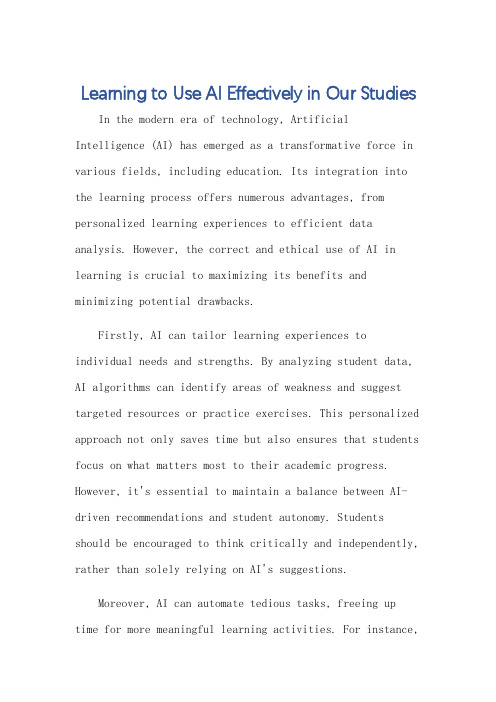
Learning to Use AI Effectively in Our Studies In the modern era of technology, ArtificialIntelligence (AI) has emerged as a transformative force in various fields, including education. Its integration into the learning process offers numerous advantages, from personalized learning experiences to efficient data analysis. However, the correct and ethical use of AI in learning is crucial to maximizing its benefits and minimizing potential drawbacks.Firstly, AI can tailor learning experiences to individual needs and strengths. By analyzing student data, AI algorithms can identify areas of weakness and suggest targeted resources or practice exercises. This personalized approach not only saves time but also ensures that students focus on what matters most to their academic progress. However, it's essential to maintain a balance between AI-driven recommendations and student autonomy. Students should be encouraged to think critically and independently, rather than solely relying on AI's suggestions.Moreover, AI can automate tedious tasks, freeing up time for more meaningful learning activities. For instance,AI-powered tools can grade assignments or provide instant feedback on writing, allowing teachers to focus onproviding deeper, more personalized guidance. Thisefficiency gain can be particularly beneficial in large classrooms or online learning environments. However, teachers and learners alike must be vigilant against over-reliance on AI for grading or assessment. AI, while powerful, is not infallible and should be used as a supplementary tool rather than a replacement for human judgment.Furthermore, ethical considerations are paramount inthe use of AI in learning. It's crucial to ensure that AI systems are designed and used in ways that promote fairness, inclusivity, and privacy. Biases in AI algorithms can leadto unequal learning outcomes, while the mishandling of student data can compromise privacy. Therefore, it's essential to prioritize transparency and accountability in the development and deployment of AI-based learning tools.In addition to ethical considerations, it's also important to recognize the limitations of AI in learning. While AI can assist in various tasks, it cannot replace thehuman touch of a teacher or mentor. The ability to ask questions, engage in discussions, and receive personalized guidance from a human educator is invaluable in the learning process. AI should be seen as a complementary tool that enhances rather than replaces human interaction in learning.Moreover, students and teachers need to be educated on how to effectively use AI in learning. This includes understanding the capabilities and limitations of AI tools, as well as developing strategies for integrating them into the learning process. Teachers should also be trained to incorporate AI into their teaching practices, ensuring that they are leveraging its benefits while mitigating any potential risks.In conclusion, the correct and ethical use of AI in learning presents significant opportunities for enhancing the educational experience. By tailoring learning experiences, automating tedious tasks, and promoting efficiency, AI can help students achieve their academic goals more effectively. However, it's crucial to strike a balance between AI assistance and human interaction,prioritize ethical considerations, and recognize the limitations of AI. By approaching AI with a mindful and responsible attitude, we can harness its power to transform learning for the better.**在学习中正确使用AI**在科技发展的现代时代,人工智能(AI)已成为包括教育在内的各个领域中的变革性力量。
英语作文自动评分
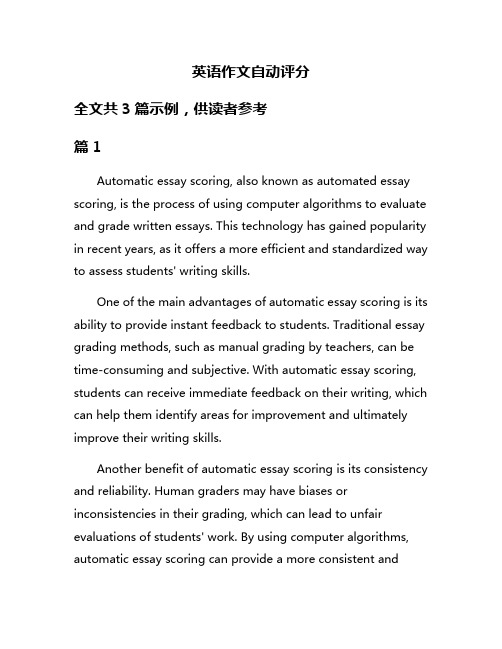
英语作文自动评分全文共3篇示例,供读者参考篇1Automatic essay scoring, also known as automated essay scoring, is the process of using computer algorithms to evaluate and grade written essays. This technology has gained popularity in recent years, as it offers a more efficient and standardized way to assess students' writing skills.One of the main advantages of automatic essay scoring is its ability to provide instant feedback to students. Traditional essay grading methods, such as manual grading by teachers, can be time-consuming and subjective. With automatic essay scoring, students can receive immediate feedback on their writing, which can help them identify areas for improvement and ultimately improve their writing skills.Another benefit of automatic essay scoring is its consistency and reliability. Human graders may have biases or inconsistencies in their grading, which can lead to unfair evaluations of students' work. By using computer algorithms, automatic essay scoring can provide a more consistent andobjective assessment of writing quality, ensuring a fair and accurate evaluation for all students.Furthermore, automatic essay scoring can help educators streamline the grading process, allowing them to focus on providing personalized feedback and support to students. This technology can save teachers time and resources, enabling them to spend more time on teaching and mentoring students rather than grading papers.Despite its advantages, automatic essay scoring is not without its limitations. Critics argue that computer algorithms may not be able to accurately evaluate the creativity, originality, and critical thinking skills displayed in an essay. Additionally, some argue that automatic essay scoring may encourage formulaic writing and discourage students from taking risks in their writing.In conclusion, automatic essay scoring is a valuable tool for educators to efficiently and objectively assess students' writing skills. While it may not be perfect, automatic essay scoring can provide students with valuable feedback to help them improve their writing abilities. As technology continues to advance, it is likely that automatic essay scoring will play an increasinglyimportant role in the assessment of writing skills in educational settings.篇2Automatic scoring of English essays has been a hot topic in the field of education and technology for many years. With the advancement of natural language processing and artificial intelligence, more and more automated essay scoring systems have been developed to provide efficient and accurate assessment of student writing.One of the most well-known automated essay scoring systems is the E-rater, developed by Educational Testing Service (ETS). E-rater uses a set of linguistic and statistical features to evaluate essays, such as word frequency, coherence, and grammar. It has been widely used in standardized tests like the GRE and TOEFL, providing quick and reliable grading for thousands of students.The benefits of automated essay scoring are numerous. It can save teachers and examiners a significant amount of time and effort by eliminating the need for manual grading. This allows them to focus on providing more personalized feedback to students and helping them improve their writing skills.Additionally, automated scoring systems are more objective and consistent compared to human graders, reducing potential biases and ensuring fair assessment for all students.However, there are also some challenges and limitations with automated essay scoring. One major concern is the inability of these systems to accurately evaluate the creativity and originality of student writing. Automated scoring systems are typically based on pre-defined criteria and templates, which may not capture the nuance and complexity of certain writing styles or topics. Additionally, there are concerns about the reliability of automated scoring, as some studies have shown discrepancies between automated and human scores.Despite these challenges, the development of automated essay scoring systems continues to advance, with researchers exploring new techniques such as deep learning and neural networks to improve accuracy and reliability. As technology continues to evolve, automated essay scoring is expected to play an increasingly important role in education, providing valuable insights into student writing and driving improvements in writing instruction.篇3Title: Automated Scoring in English CompositionIntroductionAutomated scoring in English composition is a technology that is increasingly being used in educational settings to evaluate students' writing skills. This technology uses algorithms to analyze the content, structure, and grammar of student essays, providing immediate feedback and scores. While automated scoring has its advantages, there are also concerns about its reliability and validity compared to human grading. This paper will discuss the benefits and challenges of using automated scoring in English composition.Benefits of Automated ScoringOne of the main benefits of automated scoring in English composition is the speed and efficiency it offers. With automated scoring, teachers can quickly evaluate a large number of essays, saving time and reducing the workload. Automated scoring also provides immediate feedback to students, allowing them to see their mistakes and make improvements. This can help students learn and develop their writing skills more effectively.Another advantage of automated scoring is its consistency. Unlike human graders, automated scoring systems use the samecriteria and standards to evaluate essays, ensuring that all students are assessed fairly. This can help reduce bias and inconsistency in grading, leading to more objective and reliable results.Challenges of Automated ScoringDespite its benefits, automated scoring in English composition also faces several challenges. One of the main concerns is the lack of nuance and context in automated grading. Automated scoring systems may struggle to evaluate the creativity, style, and critical thinking skills displayed in an essay, leading to potentially inaccurate scores.Another challenge is the issue of gaming the system. Students may try to manipulate the algorithms used in automated scoring to improve their scores, rather than focusing on improving their writing skills. This can undermine the integrity of the assessment process and compromise the reliability of the results.Furthermore, there are concerns about the validity of automated scoring compared to human grading. While automated scoring systems are designed to mimic human judgment, they may not be able to fully capture the complex nuances of language and writing that human graders can. Thisraises questions about the accuracy and fairness of automated scoring in evaluating students' writing skills.ConclusionIn conclusion, automated scoring in English composition offers a range of benefits, including speed, efficiency, consistency, and immediate feedback. However, there are also challenges and concerns regarding the reliability, validity, and integrity of automated scoring compared to human grading. As technology continues to advance, it is essential to carefully consider the advantages and limitations of automated scoring in English composition and strike a balance between using technology to enhance assessment practices and preserving the value of human judgment and expertise in evaluating students' writing skills.。
英语作文电脑智能自动评分系统的使用和启示

英语作文电脑智能自动评分系统的使用和启示作者:杨学前来源:《教育界》2012年第30期【摘要】英语作文电脑智能自动评分系统是指对已经输入电脑的英语作文进行自动评分的电脑软件,是对人工评分的有力补充,可以大大提高教师的工作效率。
本人以IntelliMetric 系统为例,介绍目前智能评分系统的原理,为探索在我国各级各类英语教学和考试中使用智能评分系统提供一些依据和参考。
【关键词】英语作文自动评分系统在英语作文教学中,对学生作文进行批改一直被师生共识为提高写作能力的有效手段。
但是,考虑到时间、精力、作文收发等方面,又不得不承认效率不高。
在大规模语言考试中,作文又是必不可少的题型,阅卷工作量和阅卷的信度等问题一直以来都不能让我们如意。
针对这一难题,电脑智能自动评分系统提供了可以信赖、值得期盼的解决方案。
在PEG、IEA、E-rater、冰果、MY Access、IntelliMetric等几种智能评分系统中,本文选取IntelliMetric系统进行研究,对其评价标准进行理论分析,对其所评分的作文进行跟踪评析,发现其通过对学生作文按照若干评分标准问题进行回应和打分的方法能够快速、有效地解决了作文评分的效率问题,可靠性和准确性不亚于人工评分的水平,完全可以作为人工评分的补充手段。
由此看来,智能评分系统的发展值得期盼。
一、IntelliMetric系统概述IntelliMetric系统发布于1998年1月,是第一个提供给教育机构的智能作文评分软件,相比传统的人工评阅具有许多优点,如:准确度大于个人评分,尤其大于单人人工评分;提供即时反馈等等。
发布以后,系统得到了广泛的应用。
IntelliMetric系统作为一个智能评分系统,充分模拟了人工评分的过程。
系统开发时经过了大量的测试培训,即不断通过人工纠正其自动认定的给分点,直至契合。
值得提出的是,系统不是将所有的给分点简单地相加,而是通过分析给分点之间的聚合关系,模拟人工从整体上看待作文并给出判断,这一点上跟人工评分的过程是一致的。
英语作文自动评分
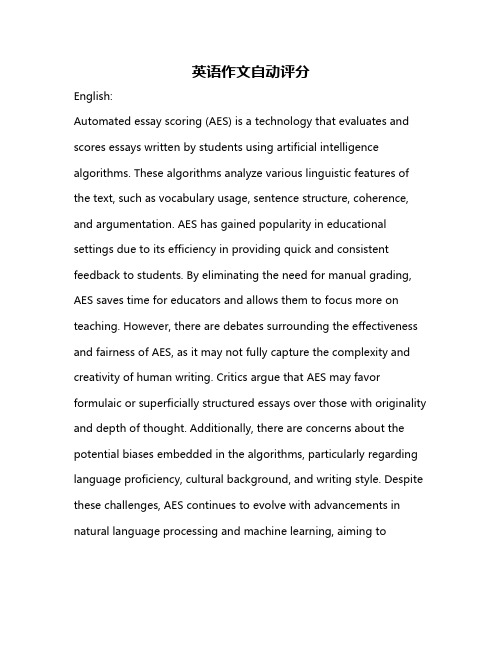
英语作文自动评分English:Automated essay scoring (AES) is a technology that evaluates and scores essays written by students using artificial intelligence algorithms. These algorithms analyze various linguistic features of the text, such as vocabulary usage, sentence structure, coherence, and argumentation. AES has gained popularity in educational settings due to its efficiency in providing quick and consistent feedback to students. By eliminating the need for manual grading, AES saves time for educators and allows them to focus more on teaching. However, there are debates surrounding the effectiveness and fairness of AES, as it may not fully capture the complexity and creativity of human writing. Critics argue that AES may favor formulaic or superficially structured essays over those with originality and depth of thought. Additionally, there are concerns about the potential biases embedded in the algorithms, particularly regarding language proficiency, cultural background, and writing style. Despite these challenges, AES continues to evolve with advancements in natural language processing and machine learning, aiming toaddress its limitations and enhance its accuracy and fairness in evaluating student writing.中文翻译:自动作文评分(AES)是一种利用人工智能算法评估和打分学生写作的技术。
itest智能测评期末作文

第一段:itest智能测评系统的引入随着科技的飞速发展,教育领域也迎来了前所未有的变革。
itest智能测评系统作为其中的佼佼者,以其高效、精准的特点,逐渐在各大院校中普及开来。
该系统通过大数据分析和人工智能算法,实现了对学生学习成果的客观、全面评价,为教育工作者提供了科学的教学辅助工具。
With the rapid development of technology, the field of education has also undergone unprecedented changes. The itest intelligent assessment system, as a leader in this field, has gradually become popular in various universities and colleges due to its efficient and accurate characteristics. Through big data analysis and artificial intelligence algorithms, the system objectively and comprehensively evaluates students' learning outcomes, providing scientific teaching aids for educators.第二段:itest智能测评系统的优势分析itest智能测评系统具备多重优势。
首先,其测评结果准确度高,能够有效减少人为因素的影响,保证评价的客观公正。
其次,该系统能够快速处理大量数据,提高了测评效率,为教师和学生节省了宝贵的时间。
此外,itest还能根据学生的学习情况,提供个性化的学习建议和反馈,帮助学生更好地掌握知识点,提升学习效果。
The itest intelligent assessment system boasts multiple advantages. Firstly, it achieves high accuracy in assessment results, effectively reducing the impact of human factors and ensuring objective and fair evaluation. Secondly, the system can quickly process a large amount of data, improving assessment efficiency and saving precious time for teachers and students. Additionally, itest can provide personalized learning suggestions and feedback based on students' learning situations, helping them better grasp knowledge points and improve their learning outcomes.第三段:itest智能测评系统在教学中的应用在实际教学中,itest智能测评系统发挥了重要作用。
英文作文电脑判分

4. 深入的语言分析,计算机评分系统可以进行深入的语言分析,评估语法、词汇、句法和连贯性等方面。这种全面的评估有助于教育者和学生更好地理解语言能力的优势和需要改进的地方。
5. 适应性学习,AI驱动的评分系统可以适应个体学习者的需求。通过分析学习者的写作模式和进步,它们可以提供定制化的反馈和练习,促进个性化的学习体验。
Adaptive Learning: AI-driven scoring systems can adapt to the individual learner's needs. By analyzing the learner's writing patterns and progress, they can provide tailored feedback and exercises, facilitating personalized learning experiences.
英文作文电脑判分
英文回答:
The advent of artificial intelligence (AI) has brought about significant advancements in various fields, including language processing. Computer-based scoring systems, powered by AI algorithms, have become commonplace for evaluating written text, offering numerous advantages.
英语作文怎么自动评分的
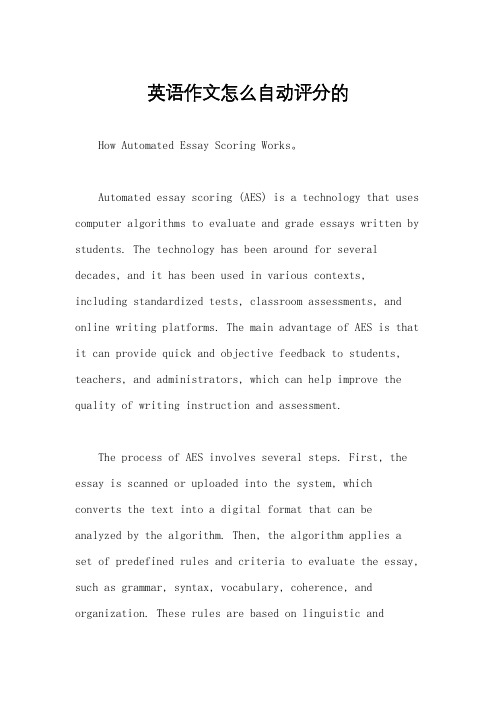
英语作文怎么自动评分的How Automated Essay Scoring Works。
Automated essay scoring (AES) is a technology that uses computer algorithms to evaluate and grade essays written by students. The technology has been around for several decades, and it has been used in various contexts,including standardized tests, classroom assessments, and online writing platforms. The main advantage of AES is that it can provide quick and objective feedback to students, teachers, and administrators, which can help improve the quality of writing instruction and assessment.The process of AES involves several steps. First, the essay is scanned or uploaded into the system, which converts the text into a digital format that can be analyzed by the algorithm. Then, the algorithm applies a set of predefined rules and criteria to evaluate the essay, such as grammar, syntax, vocabulary, coherence, and organization. These rules are based on linguistic andstatistical models that have been trained on large datasets of essays that have been manually graded by human raters.One of the most common AES methods is called the "feature-based" approach, which involves extracting a set of features or attributes from the essay, such as word frequency, sentence length, and punctuation usage. The algorithm then assigns a score to each feature based on its relevance and importance to the overall quality of the essay. The scores are combined into a final score, which represents the overall quality of the essay.Another AES method is called the "holistic" approach, which involves evaluating the essay as a whole, rather than focusing on specific features. The algorithm uses a set of criteria or rubrics to assess the essay, such as theclarity of the thesis statement, the strength of the arguments, and the effectiveness of the conclusion. The algorithm then assigns a score to each criterion based on its quality and relevance to the essay's purpose and audience.Despite its advantages, AES has some limitations and challenges. One of the main criticisms of AES is that it may not capture the complexity and creativity of human writing, and may not be able to detect subtle nuances and variations in style, tone, and voice. Another challenge is that AES may be biased or inaccurate if the training datais not representative or diverse enough, or if the algorithm is not transparent or explainable enough.In conclusion, AES is a useful and promising technology that can help improve the efficiency and effectiveness of writing assessment and instruction. However, it should be used in conjunction with human evaluation and feedback, and should be continuously refined and validated to ensure its validity and reliability.。
在学习中正确使用ai的英语作文

在学习中正确使用ai的英语作文英文回答:In the realm of education, the advent of artificial intelligence (AI) presents both immense opportunities and challenges. To harness the transformative potential of AI while mitigating its potential risks, it is imperative to adopt responsible and thoughtful practices in its implementation.1. Leveraging AI for Personalized Learning:AI-powered platforms can analyze individual student data, including academic performance, learning styles, and interests, to tailor educational experiences to their specific needs. This personalized approach enhances engagement, motivation, and ultimately, academic achievement.2. Enhancing Accessibility and Inclusion:AI-driven assistive technologies, such as speech-to-text software, closed captioning, and adaptive learning platforms, can break down barriers for students with disabilities or from diverse backgrounds. By providing equitable access to educational resources, AI promotes inclusivity and ensures that all students have the opportunity to succeed.3. Automating Administrative Tasks:AI can streamline administrative tasks, freeing up educators to focus on student-centered activities. Automated tasks, such as grading assignments, scheduling classes, and managing student records, can improve efficiency and reduce teacher workload.4. Providing Real-Time Feedback:AI-powered chatbots or virtual assistants can offer students instant feedback on their work, enabling them to identify areas of improvement and enhance their learning inreal-time. This continuous feedback loop fosters a more dynamic and interactive learning environment.5. Fostering Critical Thinking and Creativity:While AI can assist with routine tasks, it can also stimulate higher-order thinking skills. By engaging with AI systems, students develop critical thinking abilities, problem-solving skills, and creative thinking. AI-powered collaborative learning platforms allow students to share ideas, work together on projects, and learn from eachother's perspectives.6. Ethical Considerations:Responsible AI implementation requires careful consideration of ethical implications. AI systems must be transparent, unbiased, and respectful of student privacy. Educators and policymakers must prioritize the ethical development and use of AI in education.7. Teacher Training and Professional Development:To effectively integrate AI into the classroom, teachers need comprehensive training and ongoing professional development. This includes not only gaining technical skills but also developing a deep understanding of the pedagogical implications and ethical considerations of AI.8. Balancing AI and Human Interaction:AI should complement human educators, not replace them. AI systems can enhance the teaching and learning process, but they cannot substitute for the personal connection and individualized support that skilled educators provide.9. Long-Term Planning and Evaluation:The impact of AI in education will continue to evolve over time. Continuous evaluation and long-term planning are essential to ensure that AI is used in ways that maximize its benefits and mitigate potential risks.10. Collaboration and Partnerships:Effective AI implementation requires collaboration between educators, researchers, policymakers, andtechnology companies. By pooling knowledge and resources, stakeholders can work together to create innovative and responsible solutions that transform education for the better.中文回答:如何正确在学习中应用 AI.在教育领域,人工智能 (AI) 的出现带来了巨大的机遇和挑战。
自动作文评阅系统评分效度验证及教学启示

究(MBXH19YB016)”及全国高校外语教学科研项目“教育信息化背景下大学英语写作教学模式的 构建及其有效性研究(2019JX0014B)”的阶段性研究成果。
- 67 -
语 言 与 文 化 论 坛 2020 年( 第一辑)
效度论证纬度
表 1 AWE 系统效度论证框架 主要研究问题
评分 泛化 外推
影响
1. AWE 系统与人工评阅者所衡量的文章特征是否相同? 2. 作文的系统分数与人工分数是否一致?
1. 系统提供的写作任务是否充分表征写作构念? 2. 学生在完成类似的写作任务时,系统给出的分数是否相似?
作文的系统分数与其他写作任务(如多项选择题等)的分数之间存在何种关系?
- 69 -
语 言 与 文 化 论 坛 2020 年( 第一辑)
工、机器分数建立回归模型,结果表明系统评分效度低可能是因其内部缺陷所致,机器 评分主要依据浅层文本特征,不能像人工评阅那样分析深层文本特征,机器无法真正阅 读、欣赏和判断文章,并且在分析深层句型结构或词汇搭配方面的能力不足。
国内 AWE 系统开发者在不同场合多次提到系统在英语作文评阅方面十分可靠,因 此大部分高校都将此类系统融入写作教学中。但是,一个不容忽视的问题是:这些自 动系统打出的分数与人工评阅者给出的分数是否真的高度一致?现有的研究结果并不一 致。因此本研究将对国内某 AWE 系统的评分效度进行验证,以丰富该领域的研究,并 探讨研究结果对大学英语写作教学的启示。
尽管国外研究大多报道 AWE 系统效度、信度均较高,但由于多数结果由开发者提 供,鲜有独立的学者给出,因此结果的真实性不得而知。国内某系统开发者也验证了其 开发的 AWE 系统的评分效度,比较了 1456 篇 15 分制作文的机器分和人工分的结果, 发现 92.03% 的作文的分数差在 3 分以内,换言之,其相邻吻合一致性在 90% 以上。但 这一结果亦是由开发者提供,真实情况如何,有待独立研究的进一步证实。
英语作文自动评分系统的设计与实现

英语作文自动评分系统的设计与实现Designing and Implementing an Automatic Essay Scoring System for English Essays.An automatic essay scoring system (AES) is an innovative technology that uses natural language processing (NLP) and machine learning algorithms to grade English essays quickly and efficiently. This system has the potential to revolutionize the way students are assessed, saving teachers and examiners significant amounts of time while maintaining a high level of accuracy and consistency.In this article, we will explore the design and implementation of an AES for English essays, discussing the key requirements, challenges, and solutions involved.System Requirements.Before embarking on the design and implementation of an AES, it is crucial to identify the system's requirements.These requirements typically include:1. Language Support: The system should be able tohandle English essays, recognizing and understanding the nuances of the language.2. Content Analysis: The system should analyze theessay's content, looking for key elements such as coherence, organization, and grammar.3. Scoring Rubric: A clear scoring rubric should be established to guide the grading process, ensuring fairness and consistency.4. Scalability: The system should be able to handle a large volume of essays without compromising performance.5. User-friendliness: The system should have anintuitive user interface that is easy to navigate and use.Challenges and Solutions.Designing and implementing an AES for English essays presents several challenges, which can be addressed through innovative solutions:1. Language Complexity: English is a highly complex language with a rich vocabulary, syntax, and semantics. To address this challenge, the system can leverage advanced NLP techniques such as word embeddings and deep learning models. These techniques help the system capture the contextual meaning of words and phrases, enabling it to better understand the essay's content.2. Subjectivity in Grading: Essay grading can be subjective, as different teachers or examiners mayinterpret the same essay differently. To address this issue, the system can be trained using a large dataset of essays graded by multiple experts. By learning from multiple grading perspectives, the system can develop a more nuanced understanding of grading standards and reduce subjectivity.3. Scalability: Handling a large volume of essays canbe computationally intensive, potentially affecting systemperformance. To address this challenge, the system can employ distributed computing techniques, such as cloud computing or parallel processing. These techniques enable the system to distribute the grading workload acrossmultiple servers or computing units, improving scalability and performance.4. Feedback Generation: Providing constructive feedback to students is crucial for their learning and development. The system can generate feedback by analyzing the essay's strengths and weaknesses, identifying areas for improvement, and suggesting specific strategies or techniques. This feedback can be presented in a clear and actionable format, helping students understand their performance and make informed decisions about their future writing.Implementation.The implementation of an AES for English essaystypically involves several stages:1. Data Collection: Gather a large dataset of Englishessays, including both student submissions and expert gradings. This dataset should be diverse and representative of the range of essay topics and grading standards.2. Preprocessing: Clean and preprocess the collected data, removing any irrelevant or noisy information. This step may include tokenization, sentence segmentation, and removing stop words or punctuation marks.3. Feature Extraction: Extract relevant features from the preprocessed data that can be used for grading. These features may include word counts, sentence lengths, part-of-speech tags, or more complex features derived from NLP techniques such as word embeddings or semantic analysis.4. Model Training: Train a machine learning model using the extracted features and corresponding expert gradings. Various algorithms can be experimented with, such as regression models (e.g., linear regression, support vector regression), decision trees, or deep learning models (e.g., recurrent neural networks, transformers).5. Model Evaluation: Evaluate the trained model's performance using appropriate evaluation metrics such as correlation coefficients (e.g., Pearson's r), mean absolute error (MAE), or root mean squared error (RMSE). Compare the model's performance against human graders to assess its validity and reliability.6. Deployment and Integration: Deploy the trained model into a user-friendly interface that integrates withexisting learning management systems or online platforms. Ensure that the system is accessible and easy to use for both teachers and students.7. Ongoing Monitoring and Improvement: Continuously monitor the system's performance and gather feedback from users to identify any issues or areas for improvement. Regularly update and retrain the model using new data to maintain its accuracy and relevance.In conclusion, an automatic essay scoring system for English essays has the potential to revolutionize the way students are assessed. By leveraging advanced NLPtechniques and machine learning algorithms, this system can grade essays quickly, efficiently, and with a high level of accuracy and consistency. However, its design and implementation involve several challenges that need to be addressed through innovative solutions. By continuously monitoring and improving the system, we can ensure that it remains effective and relevant in supporting student learning and assessment.。
英语作文机器阅卷效果评价
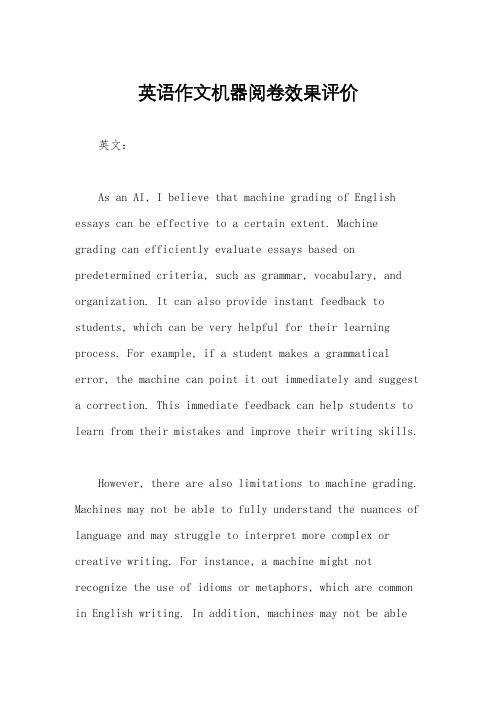
英语作文机器阅卷效果评价英文:As an AI, I believe that machine grading of English essays can be effective to a certain extent. Machine grading can efficiently evaluate essays based on predetermined criteria, such as grammar, vocabulary, and organization. It can also provide instant feedback to students, which can be very helpful for their learning process. For example, if a student makes a grammatical error, the machine can point it out immediately and suggest a correction. This immediate feedback can help students to learn from their mistakes and improve their writing skills.However, there are also limitations to machine grading. Machines may not be able to fully understand the nuances of language and may struggle to interpret more complex or creative writing. For instance, a machine might not recognize the use of idioms or metaphors, which are common in English writing. In addition, machines may not be ableto assess the content and originality of an essay as effectively as a human grader.In conclusion, machine grading of English essays can be effective in providing quick and accurate feedback on certain aspects of writing, but it may not be as reliablein evaluating more complex or creative writing.中文:作为一个人工智能,我认为机器阅卷在一定程度上是有效的。
大学英语作文机器评分

大学英语作文机器评分题目,机器评分对大学英语作文的影响。
随着人工智能技术的迅猛发展,机器评分在教育领域逐渐得到应用,尤其在大学英语作文评分中,其影响愈发显著。
机器评分的出现给教学、考试等方面带来了一系列的变化,既有积极的一面,也存在一些争议。
本文将探讨机器评分对大学英语作文的影响,并提出个人的看法。
首先,机器评分的出现大大提高了评分效率。
传统的英语作文评分需要由老师手动阅读、评定,耗费大量时间和精力。
而机器评分可以在短时间内完成对作文的评分,提高了评分的效率,减轻了教师的工作负担,为教师节省了更多的时间,使他们可以更多地专注于教学活动的设计和实施。
其次,机器评分具有一定的客观性。
相比人工评分,机器评分不受情绪、偏见等因素的影响,评分过程更加客观公正。
机器评分是基于预先设定的评分标准和算法进行评分的,不会因为个人喜好或偏见而偏离评分标准,从而保证了评分的公平性。
然而,机器评分也存在一些局限性。
首先,机器评分难以捕捉作文的深层次含义和文学价值。
英语作文不仅仅是语法、词汇的堆砌,更重要的是表达作者的思想、观点和情感,以及展现作者的文学才华。
机器评分往往只能从表面特征出发,难以理解作文背后的深层含义,容易出现评分不准确的情况。
其次,机器评分对于创造性和灵活性较强的作文评分效果欠佳。
有些优秀的作文可能采用了非传统的表达方式或结构,这种作文往往难以被机器评分所理解和评定,容易导致评分偏低。
综上所述,机器评分对大学英语作文的影响是多方面的。
它提高了评分效率,具有一定的客观性,但也存在着评分不准确、难以捕捉深层含义等问题。
因此,在使用机器评分的同时,我们也应该意识到其局限性,不可过分依赖机器评分,仍需要结合人工评分进行综合评定,以确保评分的准确性和公正性。
同时,我们也可以通过不断优化机器评分算法和提高机器理解能力来解决其存在的问题,使机器评分在大学英语作文评分中发挥更加重要的作用。
这篇文章参考了网络上下载量较高的一些范文,对机器评分对大学英语作文的影响进行了分析和探讨,并提出了自己的见解。
英语作文智能评阅系统介绍

Well done.
2.个性化反馈 2.个性化反馈
The language in your writing is generally accurate but with some errors. Your spelling is very good. You have a wide range of sentence structure and vocabulary.
2. 比较排序
综合语言和主题、内容的评估结果,进行综合评估并排序。 综合语言和主题、内容的评估结果,进行综合评估并排序。
3. 评分评语
根据排序情况、整体分析结果提供评分和个性化反馈。 根据排序情况、整体分析结果提供评分和个性化反馈。
该系统不仅给出每位学生的作文分数,还从 词汇、语法、文风、内容等方面给出意见反 馈,使每位学生了解自己的弱点、长处,为 进一步提高指出努力的方向。
英语作文智能评阅系统 英语作文智能评阅系统 智能
外语教学与研究出版社
计算机自动评阅作文的教学软件 一套服务于英语写作教学的 计算机自动评阅作文的教学软件
布置写作任务 批量下载学生的作文、系统提供的成 绩及评语
从而…… 从而……
布置充足的作文训练,并及时为学生 提供反馈 保留所有学生作文的电子文档用于教 学和科研
经一一对照筛选出值得商榷的作 文供美国研究专员进行修正,不
机器评阅
断调整,最终实现最符合人工评 判的结果
评估原理
1. 分析评估
单篇分析: 单篇分析: 基于语言学专家开发的大型词法,句法和语义规则库; 基于语言学专家开发的大型词法,句法和语义规则库;对作 文进行文本语境处理、词法分析、句法分析、语义分析、 文进行文本语境处理、词法分析、句法分析、语义分析、篇 章分析;对学生作文进行语言方面的多维度评估。 章分析;对学生作文进行语言方面的多维度评估。 横向分析: 横向分析:通过语料对比对主题和内容进行评估
ai智能英语作文初三的

ai智能英语作文初三的英文回答:Artificial Intelligence (AI) technology has thepotential to revolutionize the field of education at all levels, including secondary education for students in year 9. Here are some of the ways AI is being used in year 9 English classrooms and the benefits it offers:Personalized Learning: AI-powered learning platformscan track each student's progress, identify areas wherethey need additional support, and create personalized learning paths tailored to their individual needs and learning styles. This individualized approach helpsstudents learn more effectively and efficiently.Automated Grading and Feedback: AI can assist teachers with grading assignments and providing feedback to students. AI-powered grading systems can quickly assess student responses and provide detailed feedback, freeing upteachers' time to focus on more complex and nuanced tasks.Conversational Agents (Chatbots): Chatbots powered by AI can provide students with instant access to information and support outside of the classroom. Students can ask chatbots questions, receive clarifications, and engage in discussions, enhancing their understanding of the subject matter.Language Learning: AI-enabled language learning apps can help students develop their English language skills through interactive exercises, personalized lessons, and real-time pronunciation feedback. These apps make language learning more accessible, engaging, and effective.Creative Writing: AI can assist students with creative writing by generating ideas, providing prompts, and offering feedback on their work. This helps them develop their imagination, writing skills, and confidence.Benefits of AI in Year 9 English:Increased student engagement: AI-powered tools make learning more interactive and engaging, capturing students' attention and motivating them to learn.Improved learning outcomes: Personalized learning paths, automated feedback, and instant access to information enhance students' understanding and improve their overall academic performance.Reduced workload for teachers: AI grading and support tools free up teachers' time, allowing them to focus on providing more personalized and meaningful instruction.Enhanced communication: Chatbots and other AI-powered tools facilitate effective communication between students and teachers, fostering a supportive learning environment.Preparation for the future: AI literacy and skills are essential for students in the 21st century. Byincorporating AI into their English curriculum, students gain valuable experiences that will benefit them in higher education and their future careers.中文回答:人工智能在九年级英语教学中的应用及其优势:个性化学习,人工智能学习平台可以跟踪每个学生的学习进度,识别他们需要额外支持的领域,并创建个性化的学习路径,以满足他们独特的需求和学习风格。
ai英语作文利与弊
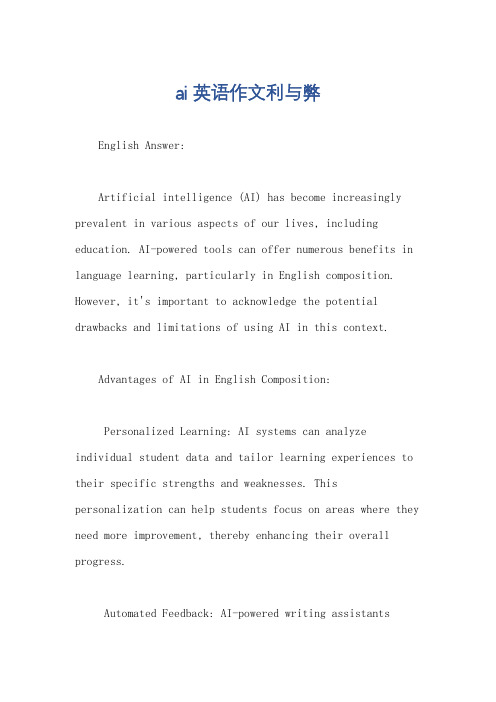
ai英语作文利与弊English Answer:Artificial intelligence (AI) has become increasingly prevalent in various aspects of our lives, including education. AI-powered tools can offer numerous benefits in language learning, particularly in English composition. However, it's important to acknowledge the potential drawbacks and limitations of using AI in this context.Advantages of AI in English Composition:Personalized Learning: AI systems can analyze individual student data and tailor learning experiences to their specific strengths and weaknesses. This personalization can help students focus on areas where they need more improvement, thereby enhancing their overall progress.Automated Feedback: AI-powered writing assistantsprovide instant and comprehensive feedback on students' writing. They can identify grammatical errors, suggest vocabulary improvements, and offer stylistic recommendations. This constant feedback loop can accelerate students' learning and improve their writing proficiency.Time-Saving for Teachers: AI tools can automate the grading and evaluation of student essays. This frees up teachers' time, allowing them to focus on providing more personalized guidance and support to their students.Enhanced Engagement: AI-powered learning platforms can incorporate interactive exercises, games, and simulations to make the learning process more engaging and enjoyable. This can motivate students to actively participate in their English composition classes.Error Reduction: AI writing assistants can help students identify and correct common grammatical and spelling errors. By eliminating these errors, students' writing becomes more polished and professional.Disadvantages of AI in English Composition:Over-Reliance and Plagiarism: If students rely too heavily on AI writing assistants, they may become less proficient in developing their own ideas and expressing themselves in writing. This could lead to plagiarism and a reduced ability to think critically.Lack of Creativity: AI systems are designed to follow established rules and patterns. While they can provide valuable feedback, they may not always encourage students to think outside the box or explore unique writing styles.Potential Bias: AI systems may be biased towards certain writing styles or perspectives. This could lead to unfair evaluations or a limited understanding of different cultural contexts.Ethical Concerns: The use of AI in education raises ethical concerns related to privacy, data ownership, and the potential replacement of human teachers. It's important to ensure that AI tools are used responsibly and ethically.Technological Limitations: AI systems are still under development and may have limitations in understanding complex language nuances or providing nuanced feedback.Overall, AI can be a valuable tool for improving English composition skills, but it should be used in conjunction with traditional teaching methods and with a critical understanding of its potential limitations. By leveraging the strengths of both AI and human expertise, we can create a more effective and engaging learning environment for English composition.中文回答:人工智能(AI)在英语写作中的利弊。
英文作文智能打分

英文作文智能打分1. What do you think about the use of technology in education?Technology has greatly impacted education in recent years. In my opinion, it has both positive and negative aspects. On one hand, technology has made learning more interactive and engaging, with the use of multimedia resources and online platforms. On the other hand, it can also be a distraction and hinder face-to-face communication and critical thinking skills. Overall, I believe technology can be a valuable tool in education if used appropriately and in moderation.2. How do you think social media affects our daily lives?Social media has become an integral part of our daily lives, and it can have both positive and negative effects. On the positive side, it allows us to connect with peoplefrom all over the world and share information and experiences. However, it can also lead to addiction, cyberbullying, and a distorted view of reality. It is important to use social media responsibly and to be aware of the potential risks and consequences.3. What is your opinion on the importance of travel?I believe travel is an important aspect of personal growth and development. It allows us to broaden our perspectives, learn about different cultures, and gain new experiences. Traveling can also help us appreciate our own lives and surroundings, and provide a break from our daily routines. However, it is important to travel responsibly and respectfully, and to be mindful of the impact our actions can have on the environment and local communities.4. How do you think the role of women in society has evolved over time?The role of women in society has evolved significantly over time, with women now having more opportunities andrights than ever before. However, there is still progress to be made in terms of gender equality and breaking down stereotypes and biases. Women have proven themselves to be capable leaders, innovators, and contributors to society, and it is important to continue to support and empower them in all areas of life.5. What is your perspective on the importance of mental health?Mental health is just as important as physical health, and it is essential to prioritize and take care of both. Mental health issues can impact every aspect of our lives, from work and relationships to overall well-being. It is important to seek help and support when needed, and to prioritize self-care and stress management. Mental health should be a priority for individuals, communities, and society as a whole.。
人工智能对当代教育的影响英语作文
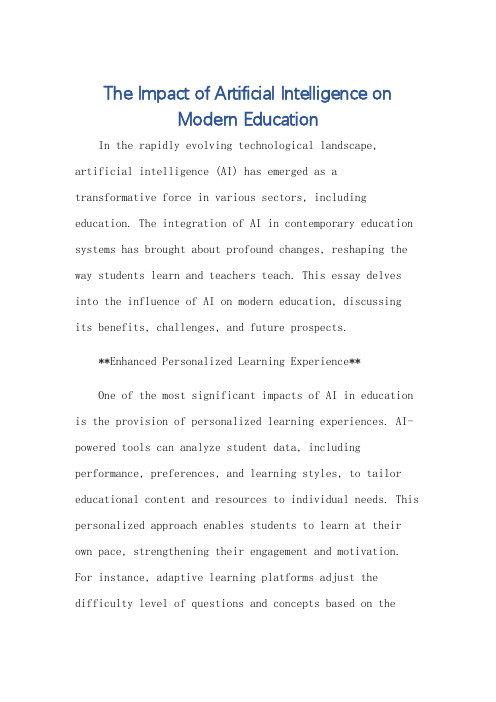
The Impact of Artificial Intelligence onModern EducationIn the rapidly evolving technological landscape, artificial intelligence (AI) has emerged as a transformative force in various sectors, including education. The integration of AI in contemporary education systems has brought about profound changes, reshaping the way students learn and teachers teach. This essay delves into the influence of AI on modern education, discussingits benefits, challenges, and future prospects.**Enhanced Personalized Learning Experience**One of the most significant impacts of AI in education is the provision of personalized learning experiences. AI-powered tools can analyze student data, including performance, preferences, and learning styles, to tailor educational content and resources to individual needs. This personalized approach enables students to learn at their own pace, strengthening their engagement and motivation. For instance, adaptive learning platforms adjust the difficulty level of questions and concepts based on thestudent's performance, ensuring a challenging yetachievable learning path.**Efficient Assessment and Feedback**AI also facilitates efficient assessment and feedbackin the classroom. Teachers can leverage AI-powered tools to automatically grade assignments, quizzes, and exams, reducing the burden of manual grading. This automation not only saves time but also ensures consistency and accuracyin grading. Additionally, AI can provide immediate feedback to students, helping them identify areas of improvement and巩固知识理解。
英语作文(自动化)简版
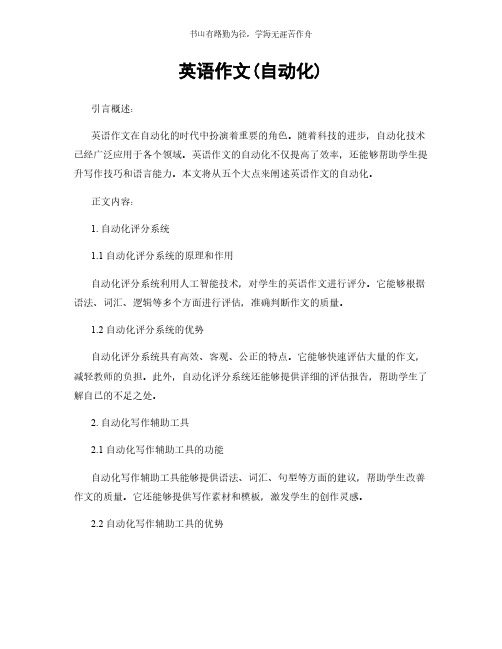
英语作文(自动化)引言概述:英语作文在自动化的时代中扮演着重要的角色。
随着科技的进步,自动化技术已经广泛应用于各个领域。
英语作文的自动化不仅提高了效率,还能够帮助学生提升写作技巧和语言能力。
本文将从五个大点来阐述英语作文的自动化。
正文内容:1. 自动化评分系统1.1 自动化评分系统的原理和作用自动化评分系统利用人工智能技术,对学生的英语作文进行评分。
它能够根据语法、词汇、逻辑等多个方面进行评估,准确判断作文的质量。
1.2 自动化评分系统的优势自动化评分系统具有高效、客观、公正的特点。
它能够快速评估大量的作文,减轻教师的负担。
此外,自动化评分系统还能够提供详细的评估报告,帮助学生了解自己的不足之处。
2. 自动化写作辅助工具2.1 自动化写作辅助工具的功能自动化写作辅助工具能够提供语法、词汇、句型等方面的建议,帮助学生改善作文的质量。
它还能够提供写作素材和模板,激发学生的创作灵感。
2.2 自动化写作辅助工具的优势自动化写作辅助工具具有便捷、实时、个性化的特点。
学生可以随时使用这些工具进行写作,提高写作效率。
此外,自动化写作辅助工具还能够根据学生的写作水平提供个性化的指导,帮助他们逐步提升写作能力。
3. 自动化翻译工具3.1 自动化翻译工具的原理和功能自动化翻译工具利用机器翻译技术,将一种语言的文本自动翻译成另一种语言。
它可以帮助学生快速翻译英语作文,提高翻译效率。
3.2 自动化翻译工具的局限性自动化翻译工具虽然能够提供快速的翻译结果,但由于语义理解和文化差异等问题,翻译质量可能不够准确。
因此,学生在使用自动化翻译工具时仍需谨慎。
4. 自动化语法检查工具4.1 自动化语法检查工具的功能自动化语法检查工具能够自动检测学生作文中的语法错误,并提供纠正建议。
它可以帮助学生改善语法表达,提高作文质量。
4.2 自动化语法检查工具的限制自动化语法检查工具虽然能够发现大部分的语法错误,但对于一些复杂的句子结构和语法问题,可能存在一定的局限性。
- 1、下载文档前请自行甄别文档内容的完整性,平台不提供额外的编辑、内容补充、找答案等附加服务。
- 2、"仅部分预览"的文档,不可在线预览部分如存在完整性等问题,可反馈申请退款(可完整预览的文档不适用该条件!)。
- 3、如文档侵犯您的权益,请联系客服反馈,我们会尽快为您处理(人工客服工作时间:9:00-18:30)。
英语作文电脑智能自动评分系统的使用和启示英语作文电脑智能自动评分系统的使用和启示内容简介:英语作文电脑智能自动评分系统的使用和启示在英语作文教学中,对学生作文进行批改一直被师生共识为提高写作能力的有效手段。
但是,考虑到时间、精力、作文收发等方面,又不得不承认效率不高。
在大规模语言考试中,作文又是必不可少的题论文格式论文范文毕业论文英语作文电脑智能自动评分系统的使用和启示在英语作文教学中,对学生作文进行批改一直被师生共识为提高写作能力的有效手段。
但是,考虑到时间、精力、作文收发等方面,又不得不承认效率不高。
在大规模语言考试中,作文又是必不可少的题型,阅卷工作量和阅卷的信度等问题一直以来都不能让我们如意。
针对这一难题,电脑智能自动评分系统提供了可以信赖、值得期盼的解决方案。
在PEG、IEA、E-rater、冰果、MY Aess、IntelliMetri等几种智能评分系统中,选取IntelliMetri系统进行研究,对其评价标准进行理论分析,对其所评分的作文进行跟踪评析,发现其通过对学生作文按照若干评分标准问题进行回应和打分的方法能够快速、有效地解决了作文评分的效率问题,可靠性和准确性不亚于人工评分的水平,完全可以作为人工评分的补充手段。
由此看来,智能评分系统的发展值得期盼。
一、IntelliMetri系统概述IntelliMetri系统发布于1998年1月,是第一个提供给教育机构的智能作文评分软件,相比传统的人工评阅具有许多优点,如:准确度大于个人评分,尤其大于单人人工评分;提供即时反馈等等。
发布以后,系统得到了广泛的应用。
IntelliMetri系统作为一个智能评分系统,充分模拟了人工评分的过程。
系统开发时经过了大量的测试培训,即不断通过人工纠正其自动认定的给分点,直至契合。
值得提出的是,系统不是将所有的给分点简单地相加,而是通过分析给分点之间的聚合关系,模拟人工从整体上看待作文并给出判断,这一点上跟人工评分的过程是一致的。
对于每一个给分点刺激和提示,IntelliMetri系统创建了一个独特的解决方案,主要的给分点、次要的给分点、聚群给分点和分散给分点,都有不同的分数赋值。
每一个刺激或提示,这相当于人工阅卷时我们先将作文的得分点做上标记,然后回过头来审视通篇看所有的这些给分点是否形成整体,主题是否突出,连贯是否流畅。
正因为如此,IntelliMetri系统能够实现令人满意的高匹配的评阅结果。
二、IntelliMetri系统评分依据IntelliMetri系统的评分依据主要根据其对作文进行的300多个变量的分析,这些变量包括语义学、造句法等与主题有关的一切因素,其数量和认定的准确度还在发展当中。
概括起来,IntelliMetri系统评分依据从宏观到微观具有几个方面功能特征:首先是聚焦度(Fous)和整体性(Unit),系统高度关注指向写作目的的聚焦度和一致性,对给分点的聚合关系赋值有统筹考虑,同时,也不排斥出现的单个观点的出现,注意到意义的关联度,做到点和面的全盘考虑。
其次是深化(Development)和拓展(Elaboration),系统关注文章内容的广度和概念的拓展深度,关注对主题的深化表述论述过程,注意意义点之间的线性关联,做到点与点的流程考虑。
三、IntelliMetri系统局限性及关于智能评分系统的思考IntelliMetri系统再好,它还是属于工具,少不了它的局限性。
首先,系统测试时大大依赖于标准的人工评阅专家。
系统需要明确的给分点提示和整体把握流程,而这样的专家往往也是仁者见仁智者见智的,很难取得统一。
输入不够导致输出局限,使用系统进行机评时我们会发现系统遗漏了给分点或整体把握不灵的情况。
从目前各种智能评分系统的使用看来,各种系统的设计都利用了多种现代信息处理技术,主要包括自然语言微观和宏观处理技术、检索技术和统计分析技术等,但由于所使用的各种技术成熟程度不同,主要由于对自然语言处理微观宏观标准的建立和人工智能化程度还远远不够,系统的分析能力难免存在较大局限性。
目前,由于涉及专利问题,各种智能评分系统所采用的自然语言处理微宏技术都还没有公开,这是一个遗憾,对我们进一步开展研究很不利。
智能评分系统在对评分模型进行训练并建立基础数据库、形成建模,是提高其工作质量,即作文评分的信度的关键。
接下来,我们应充分借鉴语言测试领域的成果,充分发展自然语言处理微宏技术,在语言表述、思想内容和结构等方面进行联动赋值,并植入智能系统。
还要在程序上进一步模拟人工流程,对自动评分模型进行反复训练调试,才能提高机评的信度,为语言教学提供强有力的辅助。
日本的《环境基本法》对噪音有明文限制:疗养部门和社会福利设施集中的地方,噪音白天在50分贝以下,夜里不能超过40分贝;市民居住区白天55分贝,夜里45分贝以下;住宅和商业、工业混合区域白天60分贝,夜里50分贝以下。
达不到标准,有关部门会加以治理。
日本人在生活中处处都小心翼翼,生怕给别人添麻烦。
白天很少见人影,也几乎看不到他们在院子里聊天。
晚上一扇扇的窗户里亮着灯光,隐约可看见一家人在看电视,却很少能听见电视声或者说话的声音。
城铁车站非常热闹,但从未听到过电车鸣笛。
电车穿过小区,只有邻近铁路的人能听到,并没有达到吵闹的地步。
高速公路上平时汽车川流不息,但声音并不算大,很少听到汽车司机摁喇叭。
瑞典:深夜不准用吸尘器大多数瑞典居民小区规定晚上9时以后不准使用吸尘器,晚上10时后不准使用洗衣机。
这样的规定虽然不是法令,但作为一种约定俗成的社会公德而被人们广泛接受。
闹得太出格,会被其他邻居告到小区物业管理处;屡教不改的,很有可能被房东请出大门。
临近周末的时候,在瑞典的许多居民小区里都可以看到这样一些业主留言:各位邻居,我们将于今晚在家中宴请宾客,届时会有较高的声响,希望各位原谅。
在瑞典,标准公寓配置的窗户都是3层玻璃,隔音效果十分突出。
一些距离主要街道较近的小区,市政管理部门规定要给居民安装4层玻璃。
德国:限速降低交通噪音德国城市同样存在噪音问题。
由于德国纬度高,冬季时间长,一般住宅的窗户都采用双层中空,这不仅起到了保温作用,也有效地降低了外界环境噪声。
尤其是靠近马路的居民楼,一般在设计时会采用降噪规格更高的窗户。
为减少道路交通噪声对居民楼的干扰,德国还在居民区限制行车速度。
在柏林的城市网状主干道之间,30公里限速区的标志随处可见。
在一些穿过居民密集区的中小干道上,还实行22时至早晨6时之间限速30公里的分时限速规定,尽量避免交通噪音对居民的影响。
另外,在居民区,建筑施工作业严格限定时段,小区露天运动场也明示开放时间,一般都禁止中午和晚上开展活动。
这些措施有效地降低了噪音扰民问题。
内容简介:可控源音频大地电磁测深在地热资源中的应用引言多年实践表明,地热资源是一种十分宝贵的综合性矿产资源,其功能多,用途广。
地热资源的综合开发利用,在社会、经济和环境效益均很显著,在发展国民经济中已显示出越来越重要的作用。
一般论文格式论文范文毕业论文可控源音频大地电磁测深在地热资源中的应用引言多年实践表明,地热资源是一种十分宝贵的综合性矿产资源,其功能多,用途广。
地热资源的综合开发利用,在社会、经济和环境效益均很显著,在发展国民经济中已显示出越来越重要的作用。
一般来说地热资源埋藏深,开采风险大。
为了减少开采风险,提高效率,开发地热资源必须进行地质调查,地球物理勘查是地热资源勘查的重要方法之一。
随着地热资源开发的难度越来越大,深度也越来越深,这就要求我们寻找更有效方法。
我们通过CSAMT法在某地的深部地热勘查中取得较好的地质效果。
1 方法简介 CSAMT法是上世纪八十年代兴起的一种物探方法。
该方法根据电磁感应的趋肤效应,高频的电磁场穿透深度浅、低频电磁穿透深度深的原因,随着频率的改变,探测深度也随之改变。
从电磁波的趋肤效应理论分析可得到趋肤深度公式:H 356■(1)式中:H为探测深度,?籽为电阻率,f为频率。
2 技术措施 CSAMT法具有信噪比高,观测信号强,设备较为轻便,生产效率高等优点。
这符合我们进行地热勘查的要求。
本次工作所使用的V8型接收机系统出队前经过了认真检查,符合有关规定,均可在野外施工使用。
在野外数据采集前与外业工作结束后均按技术要求对设备进行了标定。
经检查,标定的相位谱和电阻率谱曲线规则、光滑,符合《CSAMT法技术规定》要求。
①供电系统:电源为30kega;,个别点位因地表条件较差,接地电阻在4000 左右,采集频率同发射频率。
主要采集技术参数为:每测点按设计工作频率表依次扫频观测,每个频率叠加次数按采集时间满足1分钟或叠加60次。
自动记录、存储。
③同步系统:发射与接收采用GPS卫星时间同步,精度为0.1ns。
④观测方式:CSAMT采用赤道偶极排列。
3 实例分析该工区平行布置了4条剖面,各剖面异常形态与电性结构具相似性。
4条剖面较好地反映了不同地电特征的岩性界面。
3.1 解释思路第四系(Q):主要岩性为漂砾层,残坡积层以及冲积层,该套地层电阻率变化较大,厚度不大,分布不稳定,非本次勘查主要电性层。
CSAMT法工作主要反映工作区内垂向电性结构特征,岩体:区域岩浆岩为灰白、浅肉红色中粗粒似斑状黑云母花岗岩为主,电阻率值较高。
与地层岩性引起的异常面貌差异较大,在断面图上呈较明显叠加异常特征。
断面异常等值线密集梯级带、一定线性方向的扭曲、低值异常的一定方向的突出、异常的不连续与错位等现象预示断裂构造的存在。
3.2 解释与推断下面以通过1线卡尼亚视电阻率共轭梯度反演断面异常为例进行分析解释。
F2右侧为一高阻圈闭,上部电阻率较低推断其为震旦系地层,下部电阻率明显升高推断其为花岗岩体。
F2左侧电阻率为中低组带推断其为震旦系岩层。
根据地层接触关系推断F2右侧的高阻圈闭为地层构造运动所造成的硅化带。
F2附近电阻率梯度变化大,且具有一定线性方向故推断其为断裂带,倾角70度左右。
从剖面方向看,可明显看到一条低阻带穿过两个高阻圈闭,符合断裂带电阻率特征,故可以推断该区域存在一条F3的断裂带,倾角90度左右。
在530桩号附近密集梯级带,可能与冲沟相关,认为此面也可能是富水层位。
4 结束语通过上面工程实例的分析,可以CSAMT有如下特点:CSAMT法相对其他电磁法抗干扰能力更强,探测深度大优势相对明显,并且具有对低阻异常敏感的特点,能有效地划分断层破碎带。
CSAMT法以电阻率差异为依据,是一种间接找水的物探方法。
在利用这种方法进行找水工作时,如果很好结合工区地形地质环境,地球物理特征,和其他有关资料进行综合分析研究,可能会取得更佳实际应用效果。
关键词:英语,策略,语言普及舟山市民学习英语的策略研究摘要:英语普及率是一个城市一种软实力的重要体现,也是衡量一个城市现代化和国际化标准的重要组成部分。
